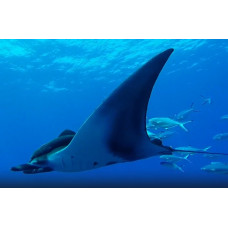Latin name
Mobula tarapacana
Other name
Box ray, greater Guinean mobula, sicklefin devil ray or the spiny mobula.
Identification
The pectoral fins of the Chilean devil ray, the base of which is behind the eyes, merge with the head to form a diamond-shaped flattened disc, wider than long, with the edges of the fins pointed ("wings"). The head is broad and flat, with the eyes set at the sides. Behind the eyes, above the point where the pectoral fins enter the body, there are tiny semicircular spiracles. The spine at the base of the tail is absent. The whip-like tail is shorter than the width of the disc. The gill rays are bicoloured. There are 5 pairs of gill slits, mouth and nostrils on the ventral surface of the disc. The dorsal surface of the disc is covered with small pointed scales and there is a prominent ridge along the spine.
Features of fish fins
The anterior part of the pectoral fins in this species is transformed into long head fins. The posterior part of the pectoral fins is concave. At the base of the tail is a small, evenly coloured dorsal fin.
Fish colouring
The colouration of the dorsal surface of the Chilean devil ray disc is smooth olive brown, the anterior part of the ventral side is white and the posterior part is grey, the colours do not mix and have clear boundaries. The white area behind the eyes is absent.
Distribution
Chilean devil rays are found in temperate and tropical waters around the world. Their range is extensive but fragmented. They are found off the coasts of Brazil, Cape Verde, Côte d'Ivoire, Egypt, Indonesia, Japan, Mexico, Palau, South Africa, Taiwan, China, USA, Venezuela and Bolivia.
Habitat
This species is found both inshore and offshore at depths of up to 30 metres, but generally not deeper than 20 metres.
Size
The maximum recorded disc width of these stingrays is 328 cm and the weight is 350 kg. The average wingspan does not exceed 2.5 metres.
Behavior
Chilean devil rays are found both individually and in groups. Sometimes these rays are washed ashore for unknown reasons.
Food and feeding habits
Their diet consists of small fish and plankton.
Reproduction
Like other Myliobatiformes, these stingrays are oviparous. The embryos develop in the womb and feed on egg yolk and histotrophs. There is one newborn in a litter.
Fishing
This species is of interest to commercial fisheries. They are caught with gillnets, seines and longlines.
Relationship with a person
The gills of the Chilean devil ray are prized, and the meat, cartilage and skin are eaten.
| Classification | |
| Phylum | Chordata |
| Class | Chondrichthyes |
| Squad | Myliobatiformes |
| Family | Mobulidae |
| Genus | Mobula |
| Species | M. tarapacana |
| Features | |
| Conservation status | Endangered |
| Habitat | Pelagic |
| Life span, years | No information |
| Maximum body weight, kg | 350 |
| Maximum length, cm | 328 |
| Sailing speed, m/s | No information |
| Threat to people | Edible |
| Way of eating | Predator |
Chilean devil ray
Tags: chilean devil ray



